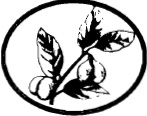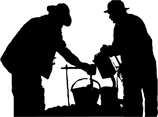Cowboy Wisdom (5 page)
Authors: Denis Boyles

- Pneumonia:
Take large cabbage leaves and wilt them over a fire to make them soft, then put the leaves all over the sick person’s chest,
sides, and back; wrap a thin cloth around them to hold the leaves on, then pour on vinegar just as hot as the patient can
stand it. The patient will begin to sweat right away, and the pneumonia will be broken up.
—A
NONYMOUS
quoted by Frost Woodhull
- Chills:
Wear nutmeg on a string around the neck.
—A
NONYMOUS PAMPHLET
c. 1890

- Malaria:
The bark of the red-bud or Judas Tree may be used as a substitute for quinine.
—E
LLEN
S
CHULZ
in
Texas Wild Flowers
- Skunk bite:
Cauterize the wound with hot iron. I know a Mexican who still lives here that was bitten on the hand while in camp alone
one night. In telling us about it, he said that he tied a rope around his wrist and then…to a tree and burned the wound with
a red-hot iron. Someone asked, “Why did you tie it to the tree?” And he said, “To keep me from running off.”
—S
HERIFF
E. E. T
OWNSEND
Brewster County 1901

- Stammering:
To cure stammering, get child near an animal that is being butchered—hog, cow, anything—and as soon as the lights are cut
out rub them vigorously in child’s face, particularly about the mouth.
—F
ROST
W
OODHULL
San Antonio, Texas c. 1930
- Thirst:
A bullet in the mouth helps some, or a dime or quarter. Copper is the best, but the prickly pear is better than any of them;
it keeps the mouth moist and agreeable longer than anything else we ever found.
And what to do with the rest of the prickly pear:
If water is muddy and you wish to settle it, peel off stickers and [the] outside of the pear, slice, and scatter over the
top of the water. They will soon sink to the bottom, carrying the sediment down with them.
—C
OLONEL
C
HARLES
G
OODNIGHT
Goodnight, Texas 1930

I
once heard Harry Halsell ask Roberts why he didn’t stop cussing, and Jimmy explained that before he learned to cuss he had
to shoot six or seven men who had cussed him.
—T
OM
Y
ARBROUGH
Fort Worth, Texas c. 1939

C
owboys had ethics and manners which were lived up to, under rules of the range. No cowboy was permitted to ask for food. The
custom was to wait till the cook cried, “chuck-away!” Then there was a wild scramble and rattling of spurs as the cowboys
rushed toward the end of the chuck wagon. The first cowboy to reach the wagon got the choice spaces between the spokes in
the wagon wheel, in which to lay his six-shooter. None was permitted to eat without removing his guns.
No cowboy was permitted to use vile language or tell offensive stories while eating. Violation of this rule meant punishment,
termed “putting the leggings on them,” which consisted in placing the offender over the wagon-tongue and whipping him with
leggings by the entire gang. If the cowboy resisted, his companions held his feet and hands while the lash was applied. Once
punished in this manner, seldom did the cowboy ever violate the rule of the range a second time.
—J
OHN
“C
ATCH-’EM-ALIVE
J
ACK
” A
BERNATHY
Austin, Texas c. 1935
K
now the rules in a cow camp when they have no regular cook. When anybody complains about the chuck they have to do the cooking.
One cowboy broke a biscuit open and says, “They are burnt on the bottom and top and raw in the middle and salty as hell, but
shore fine, just the way I like ’em.”
—A
NONYMOUS
Nebraska panhandle c. 1880

• In the wagon bed:
Bedrolls, slickers, wagon sheet, ½-in. corral rope, guns, ammunition, lantern, kerosene, axle grease, extra wheel, salt
pork, raw beef, green coffee beans, flour, pinto beans, sugar, salt, dried apples, onions, potatoes, grain for work team.
• In the tool box:
Shovel, ax, branding irons, horseshoeing equipment, hobbles, rods for pot rack, extra skillets.
• In the chuck box and boot:
Flour, sugar, dried fruit, roasted coffee beans, pinto beans, plates, cups, cutlery, castor oil, calomel, bandages, thread,
needle, razor and strop, salt, lard, baking soda, vinegar, chewing tobacco, rolling tobacco, sourdough keg, matches, molasses,
coffeepot, whiskey, skillets, Dutch ovens, pot hooks.
Some chuck wagons also had a small oven, and most had a water barrell.
—W
ILLIAM
H. F
ORBIS
in
The Cowboys
1973

Sonofabitch Stew
2 pounds lean beef
Half a calf heart
1 ½ pounds of calf liver
1 set sweetbreads
1 set brains
1 set marrow gut
Salt, pepper
Louisiana hot sauce
Kill off a young steer. Cut up beef, liver, and heart into 1-inch cubes; slice the marrow gut into small rings. Place in a
Dutch oven or deep casserole. Cover meat with water and simmer for 2 to 3 hours. Add salt, pepper, and hot sauce to taste.
Take sweetbreads and brains and cut in small pieces. Add to stew. Simmer another hour, never boiling.

2 pounds pinto beans
2 pounds ham hock (or salt pork)
2 onions, chopped
4 tablespoons sugar
2 green chilies (or to taste)
1 can tomato paste
Wash the beans and soak overnight. Drain, place in a Dutch oven, and cover with water. Add remaining ingredients and simmer
until tender. Sample the beans while cooking. Add salt to taste and water as needed.
—adapted from
Cowpoke’s Cookbook
by A
CE
R
EID
Draggin’s Ranch, Kerrville, Texas 1969

